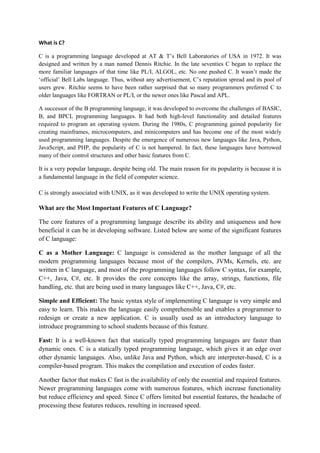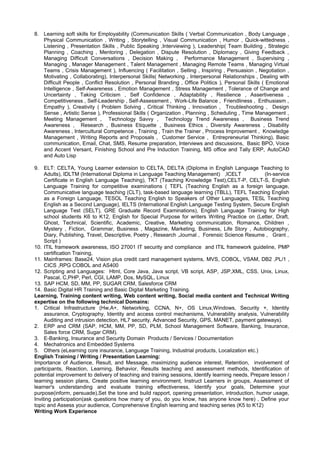PL/I: The Multifaceted Language for Mainframes

PL/I (Programming Language One) is a versatile and powerful programming language designed for mainframe computers. Developed by IBM in the 1960s, PL/I combines features from multiple programming languages, making it suitable for a wide range of applications.

Key Features

- Multiparadigm: Supports procedural, object-oriented, and declarative programming styles.
- Structured: Uses block structures, control flow statements, and data types for code organization and readability.
- Arithmetic and Data Manipulation: Includes extensive support for numeric and character data types, arrays, structures, and pointers.
- Input/Output Handling: Provides flexible mechanisms for file and database access.
- Concurrency: Supports multithreaded programming and asynchronous operations.
- Preprocessor: Built-in preprocessor for conditional compilation, macros, and inline code expansion.
- Subroutine and Function Capabilities: Allows for modular code organization and reuse.
- Exception Handling: Provides comprehensive error handling mechanisms.
- Code Generation: Produces efficient machine code for mainframe architectures.
Applications
PL/I has been used extensively in various industry sectors, including:
- Banking and finance
- Insurance
- Healthcare
- Manufacturing
- Government
- Scientific and engineering
Benefits
- Productivity: Combines multiple programming paradigms for efficient and rapid application development.
- Flexibility: Supports a wide range of application types and data structures.
- Efficiency: Generates optimized code that leverages the capabilities of mainframe processors.
- Maintainability: Structured code organization and exception handling improve code readability and reliability.
- Legacy Support: PL/I is still actively used in many legacy systems, ensuring compatibility and stability.
Market Presence
PL/I continues to be a popular programming language for mainframe environments. Major vendors such as IBM, Fujitsu, and Hitachi offer PL/I compilers and development tools.
Conclusion
PL/I remains a valuable and multifaceted language for mainframe computing. Its combination of programming paradigms, extensive data handling capabilities, and efficient code generation make it suitable for a diverse range of applications. Despite its age, PL/I continues to be a relevant and powerful language for large-scale data processing and critical business systems.## Pl/i: The Multifaceted Language For Mainframes
Executive Summary
PL/I (Programming Language One) is a third-generation programming language created in the 1960s by IBM as a universal programming language. It has been used for a wide range of applications, from writing operating systems to developing scientific and business applications. Today, it remains a popular choice for developers who need to write programs that can run on mainframes.
Introduction
PL/I is a versatile language that can be used for a variety of purposes. It is a powerful language that can be used to write complex programs, but it is also easy to learn and use. This makes it a good choice for both experienced and novice programmers.
FAQs
-
What is PL/I?
- PL/I is a high-level programming language developed by IBM in the 1960s.
- It is a general-purpose language that can be used for a variety of applications, such as scientific computing, data processing, and business programming.
-
Why is PL/I still used today?
- PL/I is still used today because it is a powerful and versatile language that can be used for a variety of purposes.
- It is also a well-established language with a large community of users and developers.
-
What are the benefits of using PL/I?
- PL/I is a powerful and versatile language that can be used for a variety of purposes.
- It is also a well-established language with a large community of users and developers.
Top 5 Subtopics of PL/I
Data Types
- Scalar Data Types: These are simple data types that can hold a single value, such as integers, floating-point numbers, and characters.
- Aggregate Data Types: These are data types that can hold multiple values, such as arrays, structures, and unions.
- Pointer Data Types: These are data types that store the address of another variable.
- File Data Types: These are data types that represent files.
- Procedure Data Types: These are data types that represent procedures.
Control Structures
- Sequential Control Structures: These are control structures that execute statements in a sequential order.
- Selection Control Structures: These are control structures that select which statements to execute based on a condition.
- Iteration Control Structures: These are control structures that repeat the execution of statements multiple times.
- Unconditional Control Structures: These are control structures that transfer the execution of statements to a specified location.
- Error Control Structures: These are control structures that handle errors that occur during the execution of a program.
Input/Output
- Sequential Input/Output: This is the simplest form of input/output, which reads or writes data from or to a file in a sequential order.
- Direct Access Input/Output: This form of input/output allows data to be read or written from or to a file at any location.
- Formatted Input/Output: This form of input/output allows data to be read or written from or to a file in a specified format.
- Unformatted Input/Output: This form of input/output allows data to be read or written from or to a file in an unformatted form.
- Error Handling: This mechanism allows errors that occur during input/output operations to be handled.
Procedures
- Procedure Declaration: This is the process of declaring a procedure in a PL/I program.
- Procedure Invocation: This is the process of calling a procedure in a PL/I program.
- Procedure Parameters: These are the values that are passed to a procedure when it is called.
- Procedure Local Variables: These are the variables that are declared within a procedure.
- Procedure Return Values: These are the values that are returned by a procedure when it is called.
Concurrency
- Multitasking: This feature allows multiple tasks to execute concurrently in a PL/I program.
- Synchronization: This mechanism allows multiple tasks to synchronize their execution.
- Deadlock Prevention: This mechanism prevents deadlocks from occurring in a PL/I program.
- Shared Memory: This mechanism allows multiple tasks to share memory.
- Message Passing: This mechanism allows multiple tasks to communicate with each other.
Conclusion
PL/I is a powerful and versatile programming language that can be used for a wide range of applications. It is a well-established language with a large community of users and developers. This makes it a good choice for both experienced and novice programmers.
Keywords
- PL/I
- Programming languages
- Mainframes
- IBM
- High-level languages
